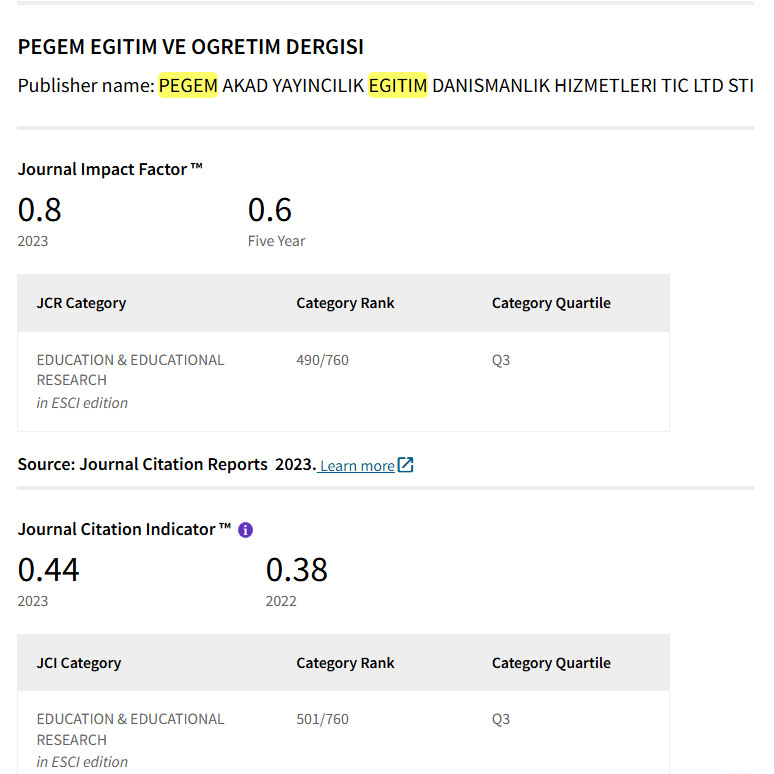The development of local curriculum for teaching Korat Songs in Thailand
DOI:
https://doi.org/10.47750/pegegog.13.03.37Keywords:
Korat songs, Singers of Korat, Compositions of Korat songs, ThailandAbstract
The objectives of this research were to: 1) develop a local curriculum for Korat songs; and 2) evaluate and certify the curriculum developed. The research tools were questionnaires, observation forms, interview forms, and evaluation forms. analyze the data for research purposes. The research results were presented descriptively, analytically, and graphically. The results of the research are as follows:
1. The local curriculum development for Korat song comprises two steps: Step 1: research and analysis of basic facts; Step 2: curriculum development and certification. This included 16 different topics with 10 learning management programs, namely: 1) the background of Korat songs 2) The legend of Korat songs 3) various aspects of the Korat song 4) Resources for studying Korat songs 5) distinct dialects and succeeding artists 6) Melody singing and playing, and 7–10) singing Korat songs
2. The outcomes of the local curriculum evaluation for Korat songs According to the agreement of nine experts, the distinctive Korat songs of the Korat people were important for their participation in education management in the current period. to increase the future generation's knowledge of Korat songs, whether in the province or elsewhere in the province. The evaluation results were suitable to an extremely reasonable extent. The mean is 4.42 and is usable for practical reasons.
Downloads
References
Atthawong, S. (2019). Political awareness and model local government: opportunities and
challenges in nakhon ratchasima province in thailand. Sumedha Journal of
Management, 8(3), 323-330.
Beckman, G. D. (2007). " Adventuring" arts entrepreneurship curricula in higher education: An
examination of present efforts, obstacles, and best practices. The Journal of Arts
Management, Law, and Society, 37(2), 87-112.
Busakorn Samrongthong. (2006). Thai music culture in the central and southern regions:
rituals and beliefs related to knowledge transfer. Bangkok: Chulalongkorn University.
Chaiwat, S. A. (2006). The silence of the bullet monument: Violence and “truth” management,
Dusun-nyor 1948, and Kru-Ze 2004. Critical Asian Studies, 38(01), 11-37.
DeKievit, M. M. (2017). Youth Identity and Regional Music in Northeastern Thailand. Doctoral
dissertation, University of Hawaiʻi at Mānoa.
DeNeui, P. H. (2002). The development of a multi-dimensional approach to contextualization
in northeast Thailand. Fuller Theological Seminary, School of World Mission.
Eamsa-Ard, L. (2006). Thai popular music: The representation of national identities and
ideologies within a culture in transition. Doctor of Philosophy, Edith Cowan University.
Georgii-Hemming, E., & Westvall, M. (2010). Music education–a personal matter? Examining
the current discourses of music education in Sweden. British journal of music
education, 27(1), 21-33.
Kaewsuwan, N., & Pornprasit, K. (2019). The The Singing Methods of Pleng Korat, a Case Study
of Khru Gamphan Khoinok (Gamphan Bantaen Band): Concepts for the Creation of the
Wiwat Pleng Korat (Evolution of Pleng Korat) Suite: The Singing Methods of Pleng
Korat, a Case Study of Khru Gamphan Khoinok (Gamphan Bantaen Band): Concepts for
the Creation of the Wiwat Pleng Korat (Evolution of Pleng Korat) Suite. Mekong-
Salween Civilization Studies Journal, 10(2), 126-168.
McCargo, D. (Ed.). (2007). Rethinking Thailand's southern violence. NUS Press.
Miller, T. E., & Williams, S. (2011). The impact of modernization on traditional musics. In The
Garland Handbook of Southeast Asian Music, 85-99. Routledge.
Mitchell, J. (2011). Red and yellow songs: a historical analysis of the use of music by the United
front for democracy against dictatorship (UDD) and the People's Alliance for
Democracy (PAD) in Thailand. South East Asia Research, 19(3), 457-494.
Phachara Suwannaphat. (2001). Worldviews of Ethnic Groups in Thailand. Korat Song. Nakhon
Pathom: Sahathamik Co., Ltd.
Phachara Suwannaphat. (2010). Knowledge Management in Mor Lam Music and Its Effects on
Traditional Korat Music Culture. Bangkok: Office of the National Cultural Commission.
Ministry of Culture.
Suwannaphachara, P. (2011). Mutto Taek: Improvisational Indigenous Knowledge in
Traditional Phleng Khorat. Fine Arts Journal: Srinakharinwirot University, 15(2), 72-83.
Thongpanya, T. (2018). Damnoen Saduak Floating Market: The construction of floating market
community identity from agricultural society to tourism community. Kasetsart Journal
of Social Sciences, 39(2), 254-261.
Wannakit, N., & Nathalang, S. (2011). Dynamics of Power of Space in the Tai-Yuan Chao Luang
Kham Daeng Spirit Cult. MANUSYA: Journal of Humanities, 14(3), 87-104.
Woolman, D. C. (2001). Educational reconstruction and post-colonial curriculum
development: A comparative study of four African countries. International education
journal, 2(5), 27-46.
Yothicar, P. (2018). A development model of cultural tourism interpretation of khao phra
wihan national park. Doctoral dissertation, National Institute of Development
Administration.
Downloads
Published
How to Cite
Issue
Section
License
Copyright (c) 2023 Pegem Journal of Education and Instruction

This work is licensed under a Creative Commons Attribution-NonCommercial 4.0 International License.
Attribution — You must give appropriate credit, provide a link to the license, and indicate if changes were made. You may do so in any reasonable manner, but not in any way that suggests the licensor endorses you or your use.
NonCommercial — You may not use the material for commercial purposes.
No additional restrictions — You may not apply legal terms or technological measures that legally restrict others from doing anything the license permits.



